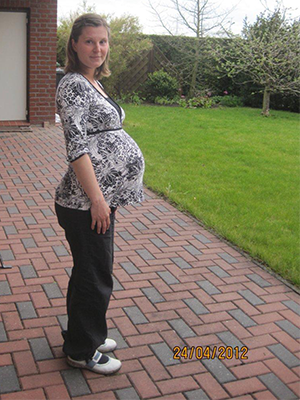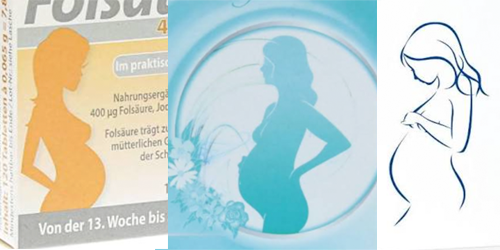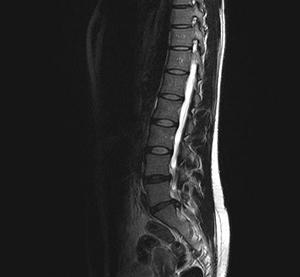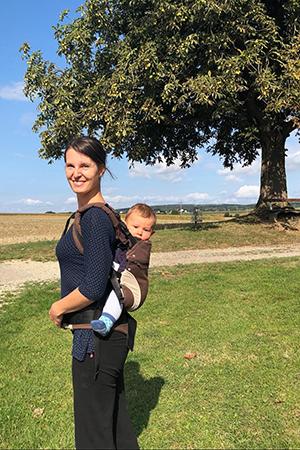Posture and Pregnancy: A Report
During my first pregnancy in 2011–12 I had — compared with other women — only a little trouble; I felt relatively fit. At the time, the occasional pain in my lower back and my permanent shoulder/ neck pain seemed normal because I had suffered them since I was in school. This fit with my modern comprehension of being healthy. Some aches and pains are not unusual. Upright posture? So not cool...

Here’s how I used to sit some years before my first pregnancy. I already suffered from occasional pain in my lower back and from permanent shoulder/ neck pain.
At the end of my pregnancy, my lower back pain became stronger. I started to suffer from sciatic nerve pain, which eventually covered the whole side of my left leg, down to my foot. It became more and more uncomfortable to sit. To avoid pain, I slowly got into the habit of only sitting on my right buttock.

Some days before my first delivery. My habit to stand with a sway back intensified with the growing weight in my belly. This malposition is seen as something normal in our society, as you can see in the following pictures.

Presentations of pregnant women on packages of dietary supplements.
When my water broke one early morning we went to hospital.
After some steps through the labor room and some belly dance movements I changed to half sit/half lie on a hospital bed because I was tired. The top of the bed was angled a little upward. At every contraction I woke up and pulled on the triangle above my head to round my back and to make the pain in my belly more bearable. At some point, the midwife told me to move onto the delivery table — an extra wide chair, also with an angled top which again put me in a C-spine shape that I was told to reinforce during every contraction. To enhance the pressure, two midwives took my feet to give me counterforce. I didn’t really feel the last contractions. I was only pressing when my midwives told me to do so.
During the ejection phase, I was told to move my pelvis a little to the left. At this point in time I realized that I had totally lost any feeling in the center of my body. My pelvis had to be moved by the midwives — I was absolutely not able to do so for myself.
Our daughter was born in the late morning hours and everything seemed to be fine. I was very glad that birth had not taken too long and that she was a healthy baby. But it was to be the beginning of a lot of trouble for me...
At home again, I still felt discomfort in my left leg. The longer I had to care for our daughter, the more pain I felt in my lower back. When my husband had to go back to work after two weeks, I got attacks of dizziness during which I had to lay down our daughter for fear of falling over. Some months later, my sciatic nerve pain was so strong that I wasn't able to bend without tears in my eyes. The doctors I visited gave me cortisone injections (although I was nursing) and told me to visit a physiotherapist. After six weeks with physiotherapy, my pain hadn't changed at all. My orthopedic specialist initiated an MRI examination. The images were unambiguous: my L5-S1 disc was herniated and protruded 2cm. The disc above it was bulged. My doctor told me that this diagnosis at the age of 28 was “nothing unusual.” My prescribed therapy: go swimming two times a week. Unfortunately, he was very busy and had only a few minutes on the phone for me…

My MRI picture from May 2013. My L5-S1 disc is herniated. The one above that is bulged. Our daughter was one year old when this MRI was taken.
I was totally desperate and sad. I felt ill and disabled from doing what nature wanted me to do. I pondered the reasons for my situation and I couldn’t help but feel like something had gone really wrong. I even had the vague idea that it has something to do with my habits. But no one was able to tell me more about that. Instead I was told that my condition was “nothing unusual”...
For another period of 6 months I was taking pain relievers, and I became more and more aware that no one was able to help me. It seemed clear that this would be my only child and that I would have to relinquish any physical training for the rest of my life. Doctors and therapists left me desperate — in my case, as in many others, there was no explanation and no solution from academic medicine.
In fall of 2013, my salvation was published in the German language: 8 Steps to a Pain-Free Back (Nie wieder Rückenschmerzen in German) by Esther Gokhale. After reading it I immediately started to learn the 8 Steps that are described because the whole approach seemed to be so logical. Since I was in parental leave I fortunately had the time to work with Esther’s book every day. And really: after two weeks I didn’t need to take any pain reliever! I couldn’t believe that the incredible became true: I was pain free and totally astonished at how mobile I was getting!
Doctors and therapists hadn’t been able to help me anyhow — but this book even told me how to heal myself! Now I got my optimism and my energy back, and I was so excited that I was eager to learn more. In May 2014 I took my little family to travel to Bristol in Great Britain. Since in Germany there had been no teacher yet, I joined the Foundations Course with John Carter who gave me useful hints and self-assurance concerning my posture and the feeling that I am doing every step correctly. And another idea was triggered by John: what if I would be the first Gokhale Method teacher in Germany to help all the people who are suffering like I was and for whom doctors only have useless tips because they don’t know what to do against “non-specific backpain”? One and a half years later I quit my job as an engineer in the automotive industry and became a Gokhale Method teacher full time!

Me and my posture in 2017, a few months before my second pregnancy.
In 2017, during the first trimester of my second pregnancy, I felt again how my joints became looser due to the hormonal changes associated with pregnancy. Every small wrong movement could cause dragging and stabbing pain. My SI-joint especially reminded me that there had been something wrong with my pelvis some years ago. I decided to regard this state as an opportunity. If all my joints are loose, I thought, my skeleton must be particularly changeable — and old issues like my aching SI-joint can be changed or even healed by healthy posture. I started to adapt my posture to my changing body. Kidney bean shaping my feet gave me a strong base for my growing weight. I especially enjoyed deep hip-hinges. They felt like medicine for my SI-joint. My plan worked. At the beginning of the second trimester I was pain-free, just like before pregnancy.
The technique that helped me most to cope with the growing weight in my belly was the rib anchor. As shown earlier, a sway back is a very common shape in pregnant women as the spine gets pulled forward. For me, as someone who had already had trouble with her discs, it was necessary to anchor my ribs against the increasing force.
The comparison of my picture diaries shows additionally which effect the change of the spine shape has on the shape of the baby bump. This is one example from week 34:

Two pictures of me at week 34 during pregnancies. On the left, during my first pregnancy, I permit my back to sway. On the right, during my second pregnancy, I engage my "rib anchor" to create a J-spine. Note that with a J-spine (right), my baby seemed to sink better into my pelvis and be more vertical.
I wondered if I might be able to affect the position of my baby through the shape of my spine. In my opinion the baby lies more vertically in the picture on the right. Does this maybe mean that with a J-spine, gravity can help the baby sink better into the mother's pelvis at the end of pregnancy? In my case, my gynecologist was very astonished every time she checked the position of my uterus. Already in week 34 the head of my baby was well settled in my pelvis.
Another point that made a big difference for me was the changed position of my pelvis while I was sitting. As you can see in the very first picture in this post, it had been my habit to retrovert my pelvis. With an anteverted pelvis I felt like there was much more room in my belly. In the second pregnancy I never suffered from pyrosis (heartburn) like I did in my first pregnancy. I also wonder if an anteverted pelvis gives a baby more of a chance to move and to turn itself to rest with the head downwards. How many babies don't rotate in time and have to be rotated by a therapist?
Although I was carrying about 3 kilos in my belly, my last pregnancy trimester was free of trouble. I had to lie down more often to save my energy and I enjoyed stretchlying on the side a lot. I remember that I hated lying down at the end of my first pregnancy. It was just impossible to find a comfortable position. Now the quality of my sleep was as high as it had ever been, even the days immediately before the birth.
The beginning of the birth was as you can read in pregnancy books. My contractions started one day in the morning about every hour and came closer over the course of the day. In the afternoon we went to the nearby hospital and they told me, after examination, that it would surely take some more time and that I should consider going home again. Since all the delivery rooms were occupied, my husband and I had to spend our time in the registration area. My contractions came closer and closer and I had no chance to lie down in between. We decided to stay. Gravity was pulling relentlessly and suddenly, at dinner time, I had contractions every 3 minutes. I asked for a delivery room and at last we got one with a huge delivery table. I'd sworn to myself that I definitely wouldn’t give birth on such a table again. I asked for a birthing stool and told the midwife that I would like to stay upright. The CTG machine (which records fetal heartbeat and uterine contractions) showed how heavy my contractions were but I grabbed the hanging cloth and concentrated on my breath. And I was astonished how bearable my contractions became! During each contraction I was half hanging/half standing with my pelvis retroverted to straighten the birth canal — one of the few times retroverting the pelvis is desirable. I was that much master of the situation and felt so good between the contractions that I was able to tell the attendant midwife student some things about posture, the Gokhale Method, and the book I'd read recently about posture during birth (“Die Gebärhaltung der Frau” by Lieselotte Kuntner). She was very interested and totally fascinated by my state. The CTG showed that the baby’s beating of the heart was constantly ideal.
Although the cervix opened very fast and the ejection phase started about two hours after we had entered the delivery room, my water didn't want to break. The amnion bulged out with every contraction and prevented the baby's head from moving forward. Even after the amnion was opened by the midwife, the head didn't move, although I was pushing very hard. I was asked to change my position and this time it was totally no problem for me. I moved from standing to sitting on the stool and later onto the delivery table to kneel down. I had a very clear perception of my whole body and each contraction. At last I was asked to turn around and to sit on the delivery table. At this point of time I would have done everything because I wanted to finally see my baby! But I tried to absolutely avoid C-shaping my spine while sitting on the table. I tried to sit as upright as possible with the support of my arms. After suffering some uncomfortable maneuvers, our son was born, exhausted but healthy, one hour before midnight.
Now, he is six months old. I have had no trouble with my back at all. I have been recovering from delivery very fast, in part because my pelvic floor isn't additionally loaded by bad posture. I feel strong and mobile. I've gotten my trust in nature back. And my understanding of being healthy has totally changed. Today I know that the human body is a fantastic construction, totally functional and strong — if it is used correctly. And I have experienced the enormous effect the state of my body has on my psyche.
I am deeply grateful that five years ago, somebody was able to tell me what had been wrong: Since I changed my posture to be more healthy, I have to admit that for the first time in my life I really feel cool — in the meaning of being relaxed and full of energy…

My son and me. Without the Gokhale Method he wouldn't be in the world.
All photos are courtesy of the author, Esther Pohl.

Comments
Dear Esther,Thank you so much
Dear Esther,
Thank you so much for sharing. I can't help but feel that this article comes as a help from heaven for me. On the morning of the day that I saw it in my inbox, I had resolved to share a video* about posture and the baby's position with Esther Gokhale, as I wanted her to pursue the subject! I'm 26 weeks pregnant with my first child. I took the Foundations course in 2014 but still seriously struggle with certain issues and now with the growing belly have had thigh/hip pain each night while sleeping on my sides. As I mentioned to Lang Liu (another teacher), I've been considering seeing an osteopath in Strasbourg (yes, I'm only an hour from Strasbourg--the world is small!), but it would be great to meet with you. I just need details on the price and location.
*The video I mentioned is by the maker of a pregnancy pillow and she shows how tilting the pelvis helps the baby's position. She does exaggerate a bit too much by sticking out the behind. https://www.youtube.com/watch?v=66xH1M1sOw4
A question: you mentioned that during the contractions it's a time to retrovert the pelvis, but then later you said that you were still doing all you could to avoid a C-shaped spine. So during the contractions you made your spine into a C-shape nevertheless?
I'm really afraid of the delivery tables, etc. that encourage bad posture, but I'm not sure a stool will be enough to support me with my exhaustion (I'm already a chronic insomniac). I'm actually visiting the maternity finally tomorrow so I'll see what they have...
A bientôt :-)
Mme Georget
Add New Comment
Login to add commment
Login